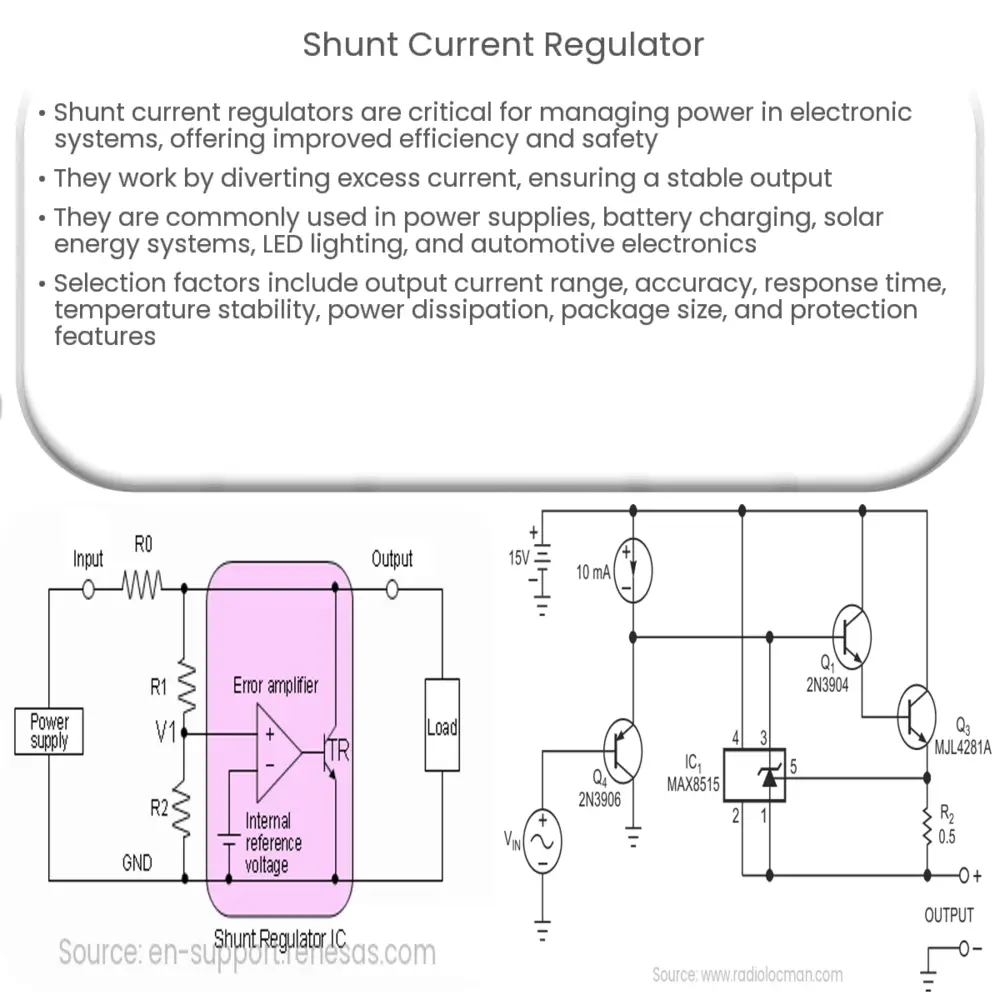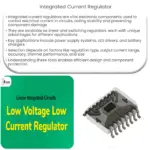A shunt current regulator stabilizes output current in electronic systems, enhancing efficiency, safety, and performance while preventing overcurrent damage.

Shunt Current Regulator: An Essential Tool for Power Management
Introduction
A shunt current regulator is a vital component in power management systems, often used for controlling and stabilizing the output current in electronic devices. This versatile tool offers several benefits, such as increased efficiency, improved power quality, and protection against overcurrent or short circuit conditions. In this article, we will explore the principles behind shunt current regulators, their applications, and key factors to consider when choosing a suitable regulator for your system.
Principles of Shunt Current Regulation
Shunt current regulators function by shunting, or diverting, excess current away from the load to maintain a stable output current level. Typically, a shunt current regulator consists of a reference voltage source, a feedback loop, and a power transistor that serves as the shunting element. The reference voltage source determines the desired output current, while the feedback loop measures the actual output current and adjusts the shunting element accordingly.
When the output current exceeds the reference value, the feedback loop signals the power transistor to divert the excess current away from the load. Conversely, if the output current falls below the reference value, the power transistor reduces the shunted current, allowing more current to flow through the load. This dynamic regulation process ensures that the output current remains stable and within the desired range.
Applications of Shunt Current Regulators
Shunt current regulators are commonly used in various industries and applications, including:
- Power supplies: They are essential in maintaining constant output current in power supplies, such as linear and switching power supplies, to prevent damage to connected devices.
- Battery charging: Shunt current regulators are used in battery chargers to control the charging current and protect batteries from overcharging or overheating.
- Solar energy systems: In photovoltaic systems, shunt current regulators manage the output current from solar panels, ensuring optimal energy conversion and preventing damage to connected equipment.
- LED lighting: They are used to maintain a stable current in LED lighting systems, enhancing the longevity and performance of the LEDs.
- Automotive electronics: Shunt current regulators are utilized in automotive systems to control the current in various electronic components and prevent damage from overcurrent or short circuits.
Key Factors to Consider When Choosing a Shunt Current Regulator
Selecting the right shunt current regulator for your system requires careful consideration of several factors:
- Output current range: Ensure that the regulator’s output current range matches the requirements of your application. A regulator with a higher current capacity than needed may result in inefficiencies, while one with insufficient capacity may not provide adequate regulation.
- Accuracy: The regulator’s accuracy is crucial for maintaining stable output current levels. Choose a regulator with high accuracy to minimize fluctuations in the output current.
- Response time: Opt for a regulator with a fast response time to ensure swift adjustments in the shunting element and maintain stable output current levels.
Temperature Stability
Temperature stability is another important factor to consider when selecting a shunt current regulator. Temperature fluctuations can impact the regulator’s performance and accuracy. Choose a regulator with a high level of temperature stability to ensure consistent operation across a wide temperature range.
Power Dissipation
Power dissipation is a critical aspect to consider as it directly affects the efficiency and reliability of a shunt current regulator. A regulator with low power dissipation will generate less heat, resulting in improved efficiency and reduced thermal stress on the components. Therefore, it is essential to select a regulator with minimal power dissipation to maximize the system’s overall efficiency and longevity.
Package Type and Size
Shunt current regulators come in various package types and sizes, which can influence their thermal performance and ease of integration into your system. Smaller packages may offer space-saving benefits but could be more challenging to dissipate heat. On the other hand, larger packages may provide better thermal performance but may occupy more space on the circuit board. Consider the available space and thermal requirements of your application when choosing a suitable package type and size for your shunt current regulator.
Protection Features
In addition to regulating the output current, shunt current regulators should also provide protection features to safeguard the system from potential damage. These features may include overcurrent protection, thermal shutdown, and short-circuit protection. Ensure that the regulator you select includes the necessary protection features for your specific application to enhance the safety and reliability of your system.
Conclusion
Shunt current regulators play a vital role in maintaining stable output current levels in various electronic systems, contributing to improved efficiency, performance, and safety. By carefully considering factors such as output current range, accuracy, response time, temperature stability, power dissipation, package type and size, and protection features, you can select the optimal shunt current regulator for your application. Ultimately, choosing the right regulator will help ensure the longevity and reliability of your electronic system while minimizing potential risks and enhancing overall performance.



